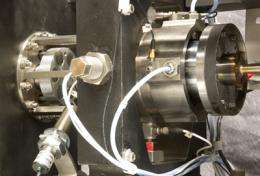SwRI researchers design and build gas bearing test rig

(PhysOrg.com) -- Researchers at Southwest Research Institute have designed and built a 60,000 rpm gas bearing test rig to test the rotordynamic stability of gas bearings.
The use of gas bearings has increased over the past several decades to include microturbines, air cycle machines and hermetically sealed compressors and turbines. Gas bearings have many advantages over traditional oil-lubricated or rolling-element bearings. Gas bearings typically have a longer life span, can accommodate high shaft speeds and can operate over a wide range of temperatures. And because there are no lubricants, there is no process contamination.
Good rotordynamic stability is important for bearings to function properly. Gas bearings are challenging to design and require a fully coupled, thermo-elastic, hydrodynamic analysis to test their stability. However, few methods exist to verify bearing stability.
"To assist industry in the design of gas bearing systems, we have designed a test rig that overcomes the many challenges of measuring rotordynamic coefficients," said Dr. J. Jeffrey Moore, a program manager in SwRI's Mechanical Engineering Division.
The test rig consists of two coaxial shafts capable of rotating at different speeds. The outer shaft, driven by an electric motor, rotates inside the foil air bearing and is responsible for generating the hydrodynamic pressure that supports the rotating shaft.
The inner shaft excites the vibration in the shaft system by using end discs where unbalance can be added and adjusted easily. Its speed is controlled by an eddy current brake system.
The bearing undergoing evaluation is supported by a cantilever bearing housing that prevents pitching of the bearing and allows the bearing to transmit forces to load cells mounted in the horizontal and vertical planes. Two accelerometers mounted on the bearing housing measure the inertial forces of the bearing in the horizontal and vertical planes, and proximity probes measure the relative displacement. A patent is being pursued on the concept.
"Development of this test rig is helping SwRI's clients achieve the design objectives of their turbomachinery," Moore said.
Provided by Southwest Research Institute

















